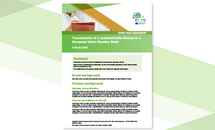Rapid risk assessment: Assessing SARS-CoV-2 circulation, variants of concern, non-pharmaceutical interventions and vaccine rollout in the EU/EEA, 15th update
Although SARS-CoV-2 transmission remains widespread in large parts of the EU/EEA, most countries report declining trends in 14-day COVID-19 notification rates, hospital and intensive care unit (ICU) occupancy, and mortality. Many countries have initiated partial lifting of different non-pharmaceutical interventions (NPIs) that aim to reduce the degree of citizens physical contact and mobility. Since January 2021, EU/EEA countries have reported an increase in the number and proportion of SARS-CoV-2 cases of variants of concern (VOC) associated with increasing transmissibility and/or severity, with Alpha (B.1.1.7) the current dominant variant across the EU/EEA. Estimates across the region show that a large proportion of the population across Europe still remains susceptible to SARS-CoV-2 and that population immunity is far from being reached. As of 3 June, the median cumulative vaccine uptake in the EU/EEA adult population (aged 18 years and older) had reached 46.2% for at least one vaccine dose and 22.3% for the full vaccination course. The highest level of vaccine uptake was observed among the elderly aged over 80, in which the uptake reached 80.5% for at least one dose and 66.3% for full vaccination coverage. For healthcare workers, the median level of at least one dose uptake was 87% and the median uptake for the full vaccination course was 65.2%. Increased vaccine supply has allowed countries to expand eligibility for vaccination to younger age groups.
Executive Summary
Risk assessed in this update
The assessment of the risk posed by the current SARS-CoV-2 pandemic is stratified by four population groups (the vaccinated and unvaccinated general population and the vaccinated and unvaccinated vulnerable population). The assessment is based on the following elements: i) the vaccinated group has a lower probability of infection and ii) a lower impact of such infection than the unvaccinated, while iii) the vulnerable population suffers a higher impact of such infection when compared with the general population. Specific separate assessments were not performed for partially vaccinated and previously infected individuals in this risk assessment, although it is known that some protection is conferred to such persons. Due to differences in the epidemiological situation, vaccination strategies and NPIs implemented, EU/EEA countries are experiencing different levels of risk posed by SARS-CoV-2 to the general population and to vulnerable groups and, thus, require different targeted interventions. ECDC classifies the epidemiological situation in EU/EEA countries into four categories based on the level of concern (low, moderate, high, very high). In most countries, the contribution of the intensity indicators to the overall score has been higher than that of the severity indicators in recent weeks. As such, the overall classification shown below provides a conservative estimate of transmission intensity.
In countries with an epidemiological situation classified as low concern, widespread transmission is falling with consequent low case notification rates. Due to the large proportion of the vulnerable population vaccinated with at least one dose, very low notification rates are recorded among the elderly. In these countries, the risk posed by the SARS-CoV-2 pandemic is assessed as low for the general population (both vaccinated and unvaccinated) and the vaccinated vulnerable population; for the unvaccinated vulnerable population there is a moderate-to-high risk.
Countries classified as moderate concern continue experiencing widespread SARS-CoV-2 transmission associated with a dominating highly transmissible variant. The highest notification rates are observed in the general population and, although a high proportion of the vulnerable population has been vaccinated with at least one dose, the probability of infection is higher than in the previous group of countries. A large part of the population is still susceptible to the infection. In these countries, the risk posed by the SARS-CoV-2 pandemic ranges from low for the vaccinated general population to high-to-very high for the unvaccinated vulnerable population.
Countries classified as high concern experience widespread SARS-CoV-2 transmission not only in the general population, but also among vulnerable individuals. The NPIs in place appear to be having a limited effect, either because adherence to the measures may not be optimal or the measures in place may not be sufficient to reduce or control exposure. Vaccination uptake in the general population and, particularly, in the vulnerable population appears to be still low. In these countries, the risk posed by the SARS-CoV-2 pandemic ranges from low-to-moderate for the vaccinated general population to very high for the unvaccinated vulnerable population.
The current assessment represents a decrease in the risk levels compared with the 14th update of the ECDC COVID-19 risk assessment published in February 2021 [1]. Still, in any of the country scenarios, should mass gathering events such as the UEFA European Football Championship take place in the absence of sufficient mitigation measures, the risk of local and pan-European transmission risk of COVID-19, including the spread of variants of concern, would increase. There is a continuous risk of the emergence and spread of variants of concern (VOCs) that are potentially more transmissible or cause serious disease or escape natural or vaccinated immunity. The VOC B.1.617.2 (Delta) associated with increased transmissibility and a slight to moderate reduction in vaccine effectiveness after one vaccine dose is rising in some EU/EEA countries. Modelling suggests that a significant increase in COVID-19-related cases in the EU/EEA remains possible when NPIs are rapidly relaxed or vaccination rollout delayed.
Options for response
One of the main public health goals in the current phase of the pandemic is to reduce severe COVID-19 disease and mortality by ensuring full vaccination for risk groups, including the elderly and those with underlying medical conditions. COVID-19 vaccination campaigns should remain a priority for all countries and vaccine rollout should continue, and possibly be accelerated whilst tailored to ensure access for vulnerable, hard-to-reach and hesitant populations.
Countries with a favourable epidemiological situation and progress toward high vaccine uptake in priority groups may consider adjusting and phasing out their NPIs, following a careful assessment of their local situation. A comprehensive testing strategy to enable the timely detection of cases and a robust system for contact tracing should remain a priority for all public health authorities.
The emergence and spread of VOCs, that are potentially more transmissible or cause more severe disease or escape natural or vaccine-induced immunity, requires strong surveillance measures and enhanced measures to stop, delay or reduce the spread of these VOCs. To be able to confirm infection with a specific variant, timely sequencing of the whole SARS-CoV-2 genome, or at least the whole or partial S-gene for current variants is required.
The risk of introduction of new variants in the EU is closely related to the pandemic evolution, within, as well as outside, of the EU. Efforts to ensure more equitable access to vaccination globally can mitigate the risk of the emergence of new variants.
Introduction of SARS-CoV-2 by travel-related cases, including of new virus variants, can play a role in triggering increased community transmission of COVID-19, particularly when levels of transmission in the receiving locality are low. As such, carefully and rigorously implemented travel measures can have an impact on the introduction and further transmission of new variants of virus, or on re-introduction of any form of virus, if local levels of transmission are low. Travel measures, including the requirement to provide proof of a negative test before travel or on arrival and quarantine for incoming individuals can be tailored according to considerations of vaccination status and VOC circulation and should be coordinated internationally.
Although increasing vaccination coverage will mitigate the effect of replacement with more transmissible variants, decisions to ease measures need to be highly sensitive to the local context and include considerations about the current viral circulation, the prevalence of VOCs and the vaccination status. Modelling analysis shows that a significant increase in COVID-19-related cases in the EU/EEA remains possible if NPIs are relaxed too rapidly.
For events with the potential to give rise to mass gatherings, such as the UEFA Euro 2020, monitoring of the epidemiological situation and implementation of preventive and mitigation measures should be done with a coordinated intersectoral approach.
Risk communication strategies need to highlight the fact that the pandemic is not over yet. People should be well informed about the need to respect NPIs that remain in place and reminded of the importance of full vaccination coverage as an effective measure to protect against infection and severe disease in priority groups and control the future transmission of the virus.








